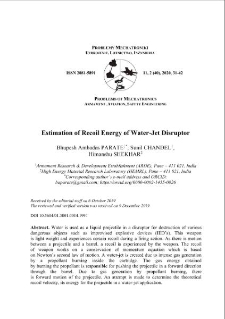Nasza Biblioteka Cyfrowa udostępnia 1 868 obiektów cyfrowych
Obiekt
Tytuł: Estimation of Recoil Energy of Water-Jet Disruptor ; Estimation of Recoil Energy of Water-Jet Disruptor
Współtwórca:
Sunil CHANDEL, Himanshu SHEKHAR ; Sunil CHANDEL, Himanshu SHEKHAR
Abstrakt:
Water is used as a liquid projectile in a disruptor for destruction of various dangerous objects such as improvised explosive devices (IED’s). This weapon is light weight and experiences certain recoil during a firing action. As there is motion between a projectile and a barrel, a recoil is experienced by the weapon. The recoil of weapon works on a conservation of momentum equation which is based on Newton’s second law of motion. A water-jet is created due to intense gas generation by a propellant burning inside the cartridge. The gas energy obtained by burning the propellant is responsible for pushing the projectile in a forward direction through the barrel. Due to gas generation by propellant burning, there is forward motion of the projectile. An attempt is made to determine the theoretical recoil velocity, its energy for the projectile in a water-jet application. The minimum and maximum recoil velocities of a water-jet varies from 2.311 m/s to 2.611 m/s. The order of magnitude for the recoil velocities is small and can be compared with a recoil of small calibre weapons that these weapons experienced during a firing mode. Based on recoil velocities, minimum and maximum kinetic energies of recoil parts are determined as 3.73 kJ and 4.77 kJ, respectively. The maximum gas force experienced by the projectile is worked out as 13.46 kN. The minimum and maximum energies to overcome the resistance force are determined as 14.657 J and 18.711 J, respectively. A small exercise for spring design is also covered.
;
Water is used as a liquid projectile in a disruptor for destruction of various dangerous objects such as improvised explosive devices (IED’s). This weapon is light weight and experiences certain recoil during a firing action. As there is motion between a projectile and a barrel, a recoil is experienced by the weapon. The recoil of weapon works on a conservation of momentum equation which is based on Newton’s second law of motion. A water-jet is created due to intense gas generation by a propellant burning inside the cartridge. The gas energy obtained by burning the propellant is responsible for pushing the projectile in a forward direction through the barrel. Due to gas generation by propellant burning, there is forward motion of the projectile. An attempt is made to determine the theoretical recoil velocity, its energy for the projectile in a water-jet application. The minimum and maximum recoil velocities of a water-jet varies from 2.311 m/s to 2.611 m/s. The order of magnitude for the recoil velocities is small and can be compared with a recoil of small calibre weapons that these weapons experienced during a firing mode. Based on recoil velocities, minimum and maximum kinetic energies of recoil parts are determined as 3.73 kJ and 4.77 kJ, respectively. The maximum gas force experienced by the projectile is worked out as 13.46 kN. The minimum and maximum energies to overcome the resistance force are determined as 14.657 J and 18.711 J, respectively. A small exercise for spring design is also covered.
Miejsce wydania:
Warszawa
;
Warszawa
Wydawca:
Wojskowa Akademia Techniczna ; Wojskowa Akademia Techniczna
Data utworzenia:
Data złożenia:
Data akceptacji:
Data wydania:
Rozmiar:
Identyfikator:
oai:ribes-88.man.poznan.pl:2582
Sygnatura:
DOI 10.5604/01.3001.0014.1991 ; DOI 10.5604/01.3001.0014.1991
ISSN elektroniczny:
ISSN drukowany:
Język:
Właściciel praw:
Wojskowa Akademia Techniczna ; Wojskowa Akademia Techniczna
Strona początkowa:
Strona końcowa:
Tom:
Słowa kluczowe:
momentum, water-jet disruptor, recoil velocity, recoil energy, gas force ; momentum, water-jet disruptor, recoil velocity, recoil energy, gas force
Kolekcje, do których przypisany jest obiekt:
Data ostatniej modyfikacji:
30 wrz 2025
Data dodania obiektu:
30 wrz 2025
Liczba wyświetleń treści obiektu:
0
Wszystkie dostępne wersje tego obiektu:
https://ribes-88.man.poznan.pl/publication/2898
Wyświetl opis w formacie RDF:
Wyświetl opis w formacie OAI-PMH:
| Nazwa wydania | Data |
|---|---|
| Estimation of Recoil Energy of Water-Jet Disruptor | 30 wrz 2025 |
Obiekty Podobne
Bhupesh Ambadas PARATE Sunil CHANDEL, Himanshu SHEKHAR, Viwek MAHTO
Bhupesh Ambadas PARATE Sunil CHANDEL, Himanshu SHEKHAR

